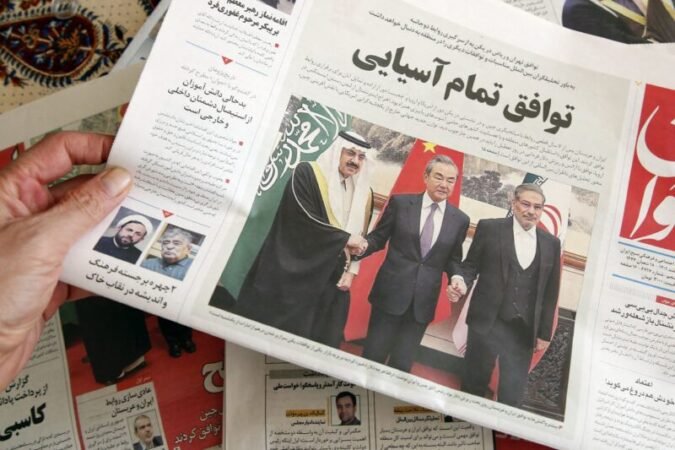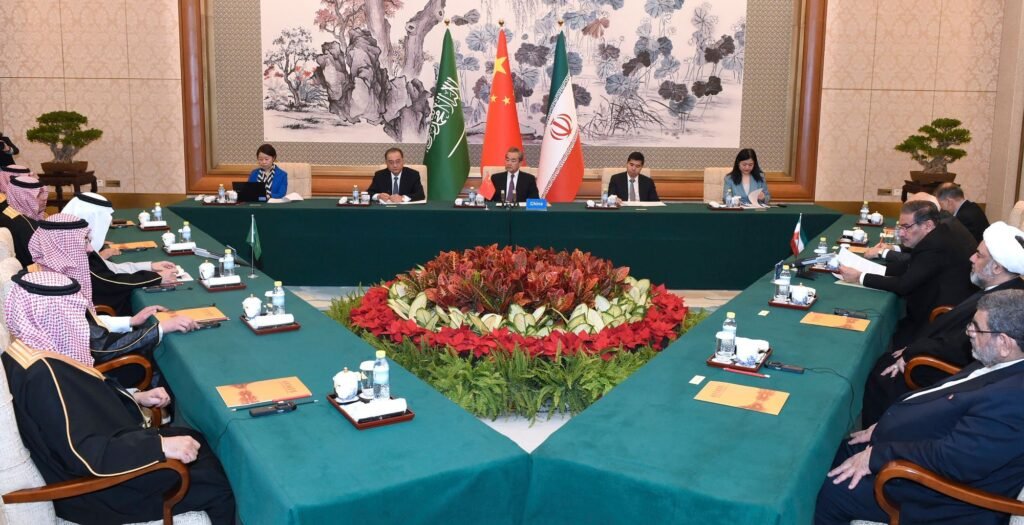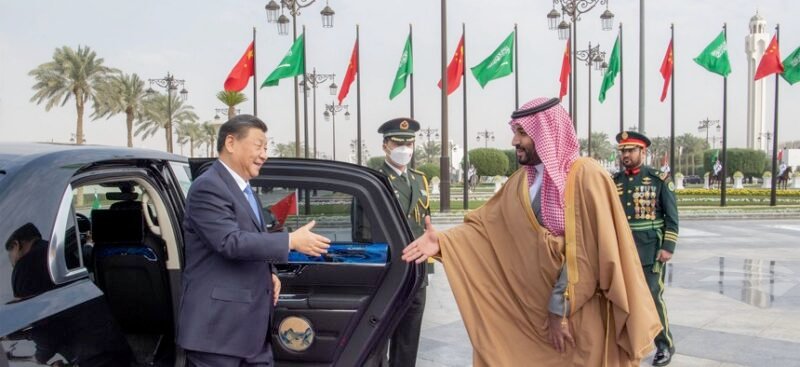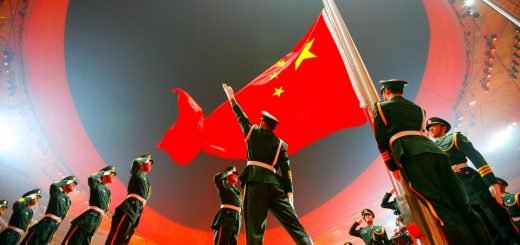Saudi-Iran Deal and China’s Growing Influence in the Middle East

Iran and Saudi Arabia have recently announced that they will restore diplomatic relations, which could have significant geopolitical implications for the Middle East. China played a significant role in brokering this deal, which represents a challenge for the United States and a victory for China. As part of the agreement, both countries have agreed to cooperate on security, reopen embassies within two months, and resume trade, investment, and cultural agreements.
However, the religious and political disagreements between the two countries run deep, making it uncertain if diplomatic engagement alone can overcome these differences. In this article, we will examine some of the key questions surrounding this deal and China’s symbolic and strategic interests.
Background and points of contention
Saudi Arabia and Iran are two major powers in the Middle East and have been engaged in a bitter rivalry for years. Here are few points:
- One of the biggest obstacles to a true thaw in relations is the sectarian divide between the two countries, with Saudi Arabia representing Sunnis and Iran representing Shiites.
- Iran has accused Saudi Arabia of being a pawn of the West and criticized its close ties with the United States. Iran has also been building a network of armed militias across the region to enhance its security and influence, which Saudi Arabia sees as a threat to regional stability.
- The role of Shiite militias in Iraq and Lebanon is another point of disagreement. Iran supports these militias to increase its regional influence, while Saudi Arabia argues that they weaken those countries.
- The future of Syrian President Bashar al-Assad is also a point of contention. Saudi Arabia wanted to help topple Assad, while Iran has helped him remain in power.
- Another major point of contention is the war in Yemen. Iran backs the Houthi rebels, whose advances prompted Saudi Arabia to launch a military intervention into the conflict to try to push them back.
These deep-rooted differences pose significant challenges to any meaningful rapprochement between the two regional powers.

Significant Global Impact
The re-establishment of ties between the two countries brings together two significant players in the Middle East with competing interests. Iran is viewed by the United States and its allies as a security threat and a source of global instability. On the other hand, Saudi Arabia is a close partner of the United States.
The rivalry between the two nations goes back decades, with each seeking to establish itself as a dominant regional power and a leader for the world’s 1.9 billion Muslims. The rift between the two nations escalated in 2016 when Iranian protesters attacked Saudi diplomatic missions following the kingdom’s execution of a dissident Shiite cleric.
In response to Iran’s nuclear program, Saudi Arabia has encouraged a harsh response from the West, and established diplomatic channels with Israel aimed at coordinating ways to confront the threat posed by Tehran. It remains unclear how the resumption of diplomatic relations between Iran and Saudi Arabia would affect Saudi Arabia’s participation in Israeli and American efforts to counter Iran.
However, this development represents a partial thaw in a cold war that has long shaped the Middle East.
Impact in the Middle East
The two countries have engaged in a war of words since 2016, with each accusing the other of supporting terrorist groups and armed militias. The Saudi-Iranian rivalry has fueled conflicts in several Middle Eastern countries, including Iraq, Lebanon, Syria, and Yemen.
The Yemen conflict, in particular, has been marked by catastrophic consequences, with Saudi bombs aimed at Iranian-backed rebels killing numerous civilians. The rebels, in turn, have responded by firing increasingly advanced missiles and armed drones at Saudi cities and oil facilities.
Although the announcement of a thaw in relations took many by surprise, Saudi and Iranian intelligence chiefs have been holding meetings in Iraq to discuss regional security in recent years. This new diplomatic engagement could provide opportunities for the two regional powers to make further progress in resolving conflicts and cooling regional tensions.

China’s strategic and symbolic interests
China’s leader, Xi Jinping, visited the Saudi capital, Riyadh, in December, and the state visit was well-received by Saudi officials, who have expressed concerns about their American allies pulling away. His visit played a crucial role in facilitating the recent diplomatic breakthrough between Iran and Saudi Arabia. The agreement highlights China’s growing political and economic influence in the Middle East, a region that has long been shaped by the United States’ involvement.
China has a vested interest in brokering a reconciliation between Iran and Saudi Arabia due to both strategic and symbolic reasons. On the strategic side, China depends on the free flow of oil from the region, particularly the Gulf, where it sources over 40% of its crude oil imports. The reduction of bilateral animosity between Iran and Saudi Arabia would lower tensions throughout the region and ensure stability in the energy market.
Symbolically, China’s role in the deal signifies its growing influence and ability to lead in global governance. Since Xi Jinping’s announcement of the Global Security Initiative (GSI), China has been on a diplomatic offensive aimed at building an alternative to the US’ dominance in global affairs. The United States’ adversarial relationship with Iran and frosty relations with Saudi Arabia made it impossible for them to broker this agreement, despite being the preeminent external power in the region for 75 years. China’s efforts to reduce tensions in the region, particularly through this deal, could position it as the leader of a new, alternative multilateral order.
The deal could also have significant implications for the international energy market, as some speculate it could pave the way for the Petroyuan, whereby oil transactions would be settled in yuan, rather than the US dollar. China recently secured such an arrangement with Iraq, and other countries have considered similar options amid US sanctions on Russia.
China’s emphasis on the importance of sovereignty and non-interference in domestic affairs makes it an appealing interlocutor for Saudi Arabia and Iran, despite their notorious human rights abuses. Both countries have expressed interest in joining the BRICS, a powerful economic bloc and political force made up of Brazil, Russia, India, China, and South Africa. Furthermore, Iran is set to become a member of the Shanghai Cooperation Organization, a Eurasian political, economic, and security grouping headquartered in Beijing, and there is talk of Saudi Arabia joining.
As China positions itself as the leader of an emerging, alternative multilateral order and a responsible great power, it hopes that its role in brokering the Iran-Saudi Arabia deal will be viewed as an example of its growing clout and ability to lead in global affairs.
What’s in for Saudis?
Saudi Crown Prince Mohammed bin Salman’s move toward regional reconciliation with Iran is seen by analysts as part of his more pragmatic approach to foreign policy. For years, Saudi Arabia was known for its predictable foreign policy, but the Crown Prince has upended that since rising to power in 2015. He intervened in Yemen’s civil war, cut ties with neighbouring Qatar, and pushed Lebanon’s prime minister to resign.
However, he has recently pursued a more conciliatory approach, mending the rift with Qatar, easing tensions with Turkey, and pursuing peace talks in Yemen. This new approach is partly driven by his desire to overhaul nearly every aspect of life in Saudi Arabia under his “Vision 2030” plan. His vision calls for diversifying the oil-dependent economy by attracting tourism and foreign investment, drawing millions of expatriates to the kingdom, and making it a global hub for business and culture.
Calming regional tensions is central to that vision and is also driven by his desire to turn Saudi Arabia into a global power and make it less dependent on the United States. Although Saudi Arabia still relies heavily on the US for its weapons and defensive systems, the Crown Prince has been looking for ways to build deeper ties with other global powers, such as China, India, and Russia.


















